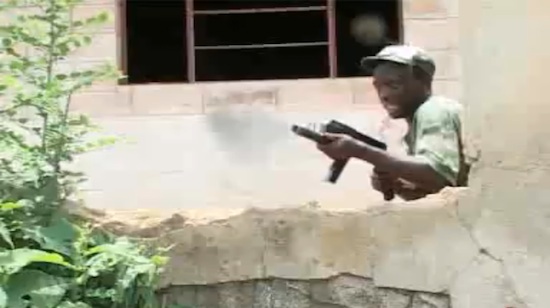Who Killed Captain Alex?: Uganda’s Greatest, Only Action Movie
Over the past few days, the kids with their Tumblrs have been rediscovering the trailer for a Ugandan movie called Who Killed Captain Alex? If you’re wondering why, it’s because this isn’t just any movie: It has the distinction of being the first action movie made by the Ugandan film industry, courtesy of a studio called Ramon Film Productions. And it is so transcendently, beautifully, well – bad, we want it on DVD right now. Where to begin?
How about:
*The hyperactive young narrator who repeatedly reminds you that the movie is both an action movie and for sale, and who makes Fred sound like a dignified elder statesman
*The fact that whenever a gun is fired, it emits glowing yellow muzzle fire; whenever someone is shot or wounded, they emit glowing red blood; sometimes, when someone is shot their skin produces glowing yellow muzzle fire for some reason
*The scene at about the 26 second mark when a helicopter destroys an entire city, apparently just by sitting on it
*What the hell is going on at the 45 second mark
*The fact that this is actually an extremely violent and disturbing movie about a war between police and drug dealers, and features the brutal deaths of women, children, and roofs, but you just can’t take it seriously
According to Ugandan newspaper The Observer, Who Killed Captain Alex? is about the aftermath of a police raid in Kampala, Uganda’s capital, in which a police captain (Alex) and a drug racketeer’s brother are killed, and both sides seek revenge, “escalating into ‘war.'” The article sheds further light on the film’s production, which apparently required some creativity when Uganda’s Central Police Station wouldn’t give the filmmakers anything to work with except uniforms:
It is a well scripted movie, but the visuals are too graphic. Nabwama says, he just wanted to produce an action movie, acted, produced and directed by Ugandans. But he can’t be forgiven for using toy guns and pistols in the production.
“When we approached CPS about the project, we were told that we [film industry] are not yet at that level. They could only provide us with police uniforms,” he says. “But we had asked them to provide us with helicopters, guns, tankers and access to army barracks. So we had to settle for the computer.”
The article quotes a cost of 8 million Uganda shillings, which converts to about $3500; it’s unclear if this is cost per major scene or cost for the whole film. Either way, the American movie industry could learn a lot from this movie’s pluck and economy. And good news! There’s apparently a sequel on the way.
(via TDW, The Observer)
Have a tip we should know? [email protected]
